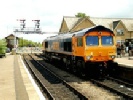Archive Section




7th February 2012
Charles Devereux, Head of Operations, Crossrail
For this month, we welcomed Charles Devereux (Head of Operations, Crossrail) who gave a wonderfully detailed insight into the changes being made “below the streets of London”.
The history
January 1989 -
ln the beginning
February 2005 -
July 2008 -
The facts-
Crossrail is needed! A route to interweave through existing ‘overground’ lines and tube tunnels. Fully integrated with other forms of transport throughout London. Up to 4000 buildings and 50 other LUL tunnels in close proximity, Purpose built tunnels from Westboume Park (Paddington) through to Pudding Mill and Royal Victoria. Use of existing lines to Heathrow/Maidenhead, plus Stratford/Shenfield & Abbey Wood. (90km of existing surface lines in total). Independent analysis predicts significant employment and population growth on the east-
ln a world without Crossrail, the following will still occur-
If only 50% ofthese workers use rail, then 318,000 new people will use the existing rail infrastructure.
Crossrail will provide significant relief to the existing Hammersmith & City and Metropolitan tube lines, and also alleviate crunch points of other lines/interchanges.
The figures-
Fast running beneath London f up to 60 mph.
Maidenhead -
Heathrow Airport -
The new trains & stations
Built to W6 gauge. 18% lighter than existing trains. Up to 1500 passengers. 450 seats. 200m in length.
The tender for the actual trains is expected to be let during 2012. At peak times, trains will run up to every 2mins. Up to 30 trains per hour, giving capacity for 45,000 passengers in each direction. 27 stations to be served by Crossrail.
61 platform extensions to current stations. 146km of electrification. A new flyover at Airport Junction (Hayes).
New station layouts at Maidenhead & Abbey Wood.
The tunnels
21 km of new twin-
The London terrain is complex: clay, building foundations, other tube lines and underground springs all have to be taken into consideration. Air conditioning in tunnels and stations require wider tunnelling to allow for airflow. Enhanced train designs to accommodate air conditioning. Greater technology as a result. Re-
The other bits
Active talk of Crossrail '2'. Skills and knowledge transfer to future projects. Excavated waste material (to Wallasea Island RSPB land reclamation bird sanctuary)-
Grade l listed problems on existing stations and adjacent properties.
Old Oak Common Depot-